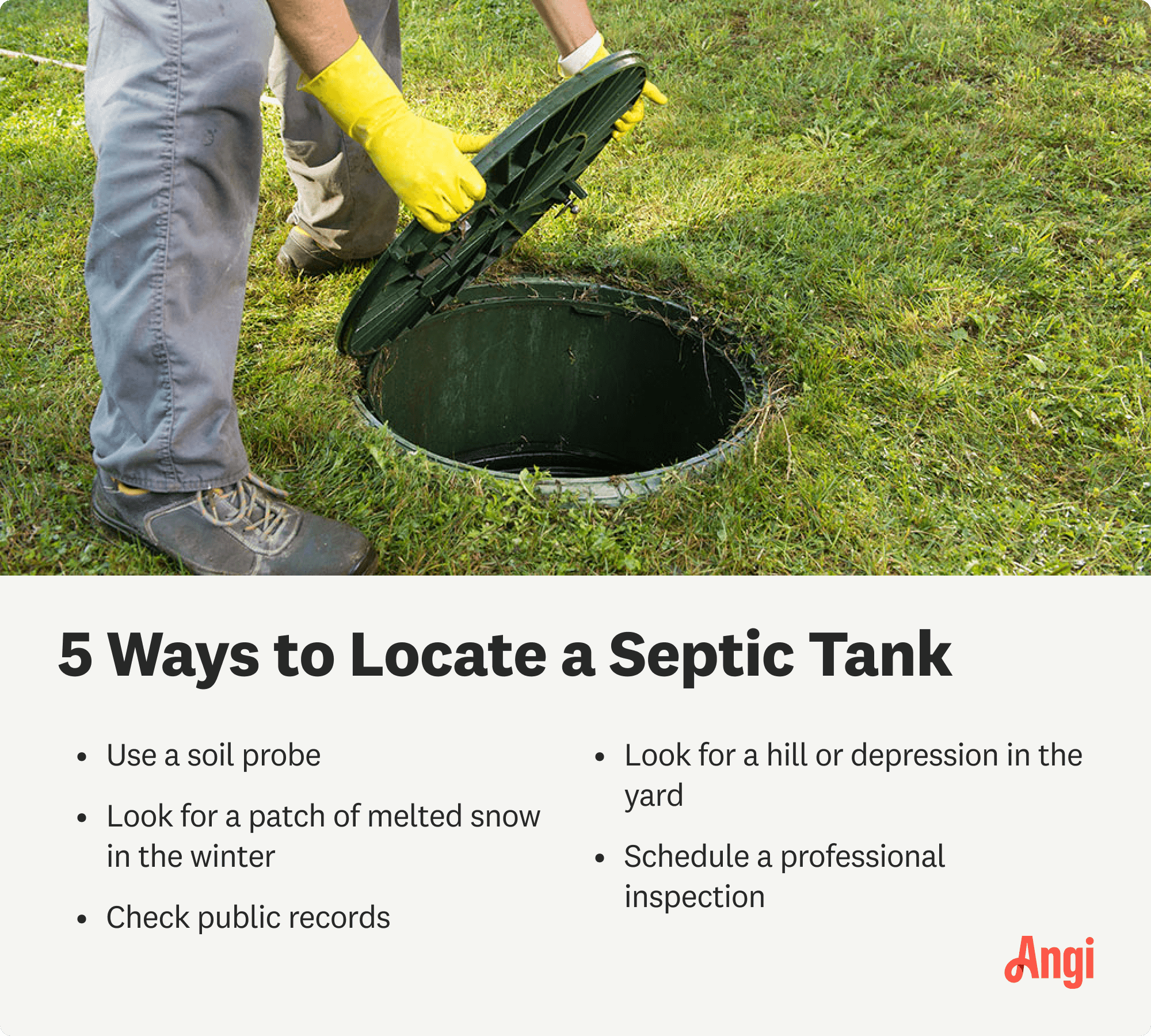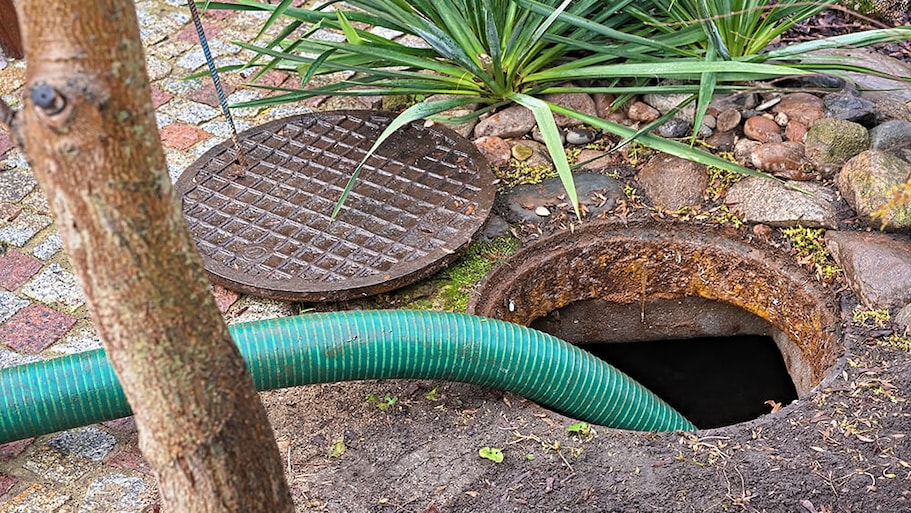How Much Does It Cost to Locate a Septic Tank? [2025 Data]
Locating a septic tank costs $400 on average, but it commonly costs between $100 and $900 depending on the method you use to find it and if you need a pro’s help.


Check your property records and contact your building department for permit notes to find your septic's location.
Bumps or depressions in your lawn can suggest the septic tank location.
You can use a soil probe or hire a septic professional to scan your yard.
The last septic company that pumped your tank may have records that reveal the location.
Septic tanks can be between 4 inches and 4 feet below the surface. The depth affects how easy and affordable it is to locate the tank.
How much does it cost to locate a septic tank? Costs range from $10 to about $1,175 for an advanced professional inspection with a sewer camera. The budget for this project depends primarily on whether you can find the septic tank yourself or hire a septic tank company to pinpoint the location.
You may need to locate the septic tank if you plan to have it pumped soon or if you’re trying to landscape your lawn without interfering with the tank. Find out the costs to hire someone to help you find it compared to buying a device to locate it yourself.
Locating a Septic Tank Cost Breakdown
The cost of locating a septic tank mostly depends on whether you are finding the tank yourself or hiring a local septic tank company to determine the location. Other factors, like size and location on the property, may have some impact on the cost.
Size
Finding the tank costs about the same no matter the size of the septic tank, but you may pay more if you are having a pro inspect a larger tank. That’s because during an inspection, the septic system specialist isn’t just flagging where the tank is located—they are also taking a close look at the system for any damage. This process will take longer for a larger tank, and larger tanks are more common on bigger properties.
Inspection Type
If you’re hiring a pro, the cost varies by the type of inspection needed. Having someone come inspect the septic tank as part of your regular maintenance costs about $100 to $450, but an in-depth inspection, which includes a pro snaking plumbing cameras into the pipes, can cost about $900.
| Inspection Type | Average Cost |
|---|---|
| Basic | $100–$450 |
| Detailed | $400–$700 |
| Title V | $500–$900 |
| Camera | $250–$1,175 |
Labor
Hiring a septic company to come inspect the property for the septic tank will cost about $100 to $450 total, or the company may charge a rate of $100 to $300 per hour. With an inspection, the pro will locate the tank and check it for signs of damage, and they can recommend repairs or septic system maintenance, like pumping the tank.
Location
Septic tanks may be buried about four inches to four feet underground. For septic tanks that are buried about two feet or less, you may be able to spot them just by looking around the yard or using a soil probe. This will cost you less than $25.
If the septic tank is buried pretty deep, about four feet, you may have a harder time finding it with a soil probe. In that case, you may need to spend $100 to $450 for a professional inspection.
Cost by Inspection Type

If you decide to hire a septic company to help you identify where your septic tank is located, you may spend $100 to $1,175 based on the type of inspection. If you think there’s something wrong with the system, you will want to pay more for a more detailed inspection.
| Inspection Type | Description | Cost |
|---|---|---|
| Basic | Checks for leaks and measures waste | $100–$450 |
| Detailed | Checks everything from plumbing to leach field, tests soil | $400–$700 |
| Title V | Required for selling or expanding property | $500–$900 |
| Camera | Camera goes into main line or plumbing pipes to check for problems | $250–$1,175 |
Septic Tank Ongoing Expenses
Septic systems may save homeowners on the cost of monthly utility bills, but they still have long-term costs to consider. Pumping the septic tank, inspecting the system, and making repairs as needed will all add to the cost of a septic system. Homeowners may also consider costs for upgrades, like septic tank landscaping ideas or added insurance coverage.
Pumping a septic tank costs $250 to $1,250.
Ongoing maintenance replaces standard utility operating costs.
Repairing a septic tank costs $630 to $3,000.
Sewer backup insurance costs $50 to $250 per year.
Sewer line replacement costs between $1,300 and $5,000.
Service line coverage insurance costs $20 to $50 per year.
Ways to Save on Locating a Septic Tank

Locating a septic tank isn’t expensive if you’re just wondering where on your property it is. You can save big by obtaining your property records, which will show the tank location, or using a soil probe. However, if you need a professional inspection, there are still ways to save on the cost.
DIY: Labor is the biggest factor for how much it costs to locate a septic tank. If the tank is buried about two feet, you may be able to find it on your own for $25 or less.
Pump the tank: The septic tank needs to be pumped every three to five years, so knock out two tasks at once by having the company find the septic tank when they come to pump it.
Check your insurance: If you suspect accidental damage to your septic tank and are trying to locate it, your homeowners insurance policy may cover some repair costs.
DIY Locating a Septic Tank vs. Hiring a Pro
Locating your septic tank is easy to handle on your own. You can simply walk outside on a snowy day and look for an area of melting snow, since the tank generates some natural heat underground. If that doesn’t work, you can also look around for a small mound or depression in the yard where the tank is buried. A soil probe, available for around $25, can help locate tanks buried two feet or less in the ground. Another option is to check county records, which will have your septic tank location, and this option is free or may cost you under $1 if you choose to purchase copies of the records.
By comparison, hiring a local septic company may cost about $100 for a basic inspection or up to $1,175 for a camera inspection. While this cost may be higher, it can save you lots of time. Not only that, but if you’re wondering where the tank is because you think it may be damaged or needs to be pumped, only a pro can handle septic tank repairs or pumping anyway. Hiring a pro to do the inspection and pumping or repairs at once could save you money.
How Angi Gets Its Cost Data
Home is the most important place on earth, which is why Angi has helped more than 150 million homeowners transform their houses into homes they adore. To help homeowners with their next project, Angi provides readers with the most accurate cost data and upholds strict editorial standards. We extensively research project costs to develop the pricing data you see, so you can make the best decisions for you and your home. We rely on reputable sources, including the U.S. Bureau of Labor Statistics, academic journals, market studies, and interviews with industry experts—all to ensure our prices reflect real-world projects.
Want to help us improve our cost data? Send us a recent project quote to costquotes@angi.com. Quotes and personal information will not be shared publicly.
Frequently Asked Questions
Septic tank locations are sometimes public record, although it depends on local laws and the property age. Older properties may not have the septic tank information on public record. To check, you can talk to local permitting agencies, such as your local health department, the local environmental department, or the county clerk.
Septic tanks are typically buried between four inches and four feet deep, depending on the property, the soil, and the size of the tank. When the septic tank is buried on the deeper end of this range, it may be harder for you to locate it on your own with a soil probe or just by observing the yard for signs of the tank. However, if you have trouble finding the septic tank, a pro will be happy to help you.
The septic tank needs to be pumped at least every three to five years. If the septic tank is too small for the property, you might find it needs to be pumped more frequently, and during an inspection, a septic company may recommend updating your system to a larger septic tank. While 750-gallon tanks used to be standard, septic tanks with a 1,250-gallon capacity are now more common.
Yes. A metal detector is one of the quickest and easiest ways to find your septic tank. However, metal detectors can be too expensive (costing upward of $300 in some cases), and not everyone has a metal detector just lying around. If that’s the case for you, you can also take a long metal rod and poke it into the ground at regular intervals until you hit something—likely your septic tank lid.
According to the Environmental Protection Agency (EPA), septic tanks must be located a decent distance from places subject to flooding or surface ponding. Additionally, septic tanks should be installed on level ground so that the waste can properly settle in the tank. Most tanks are located 10 to 20 feet away from the home. More specific requirements vary by location, so call a local septic pro or your local health department for more information.















